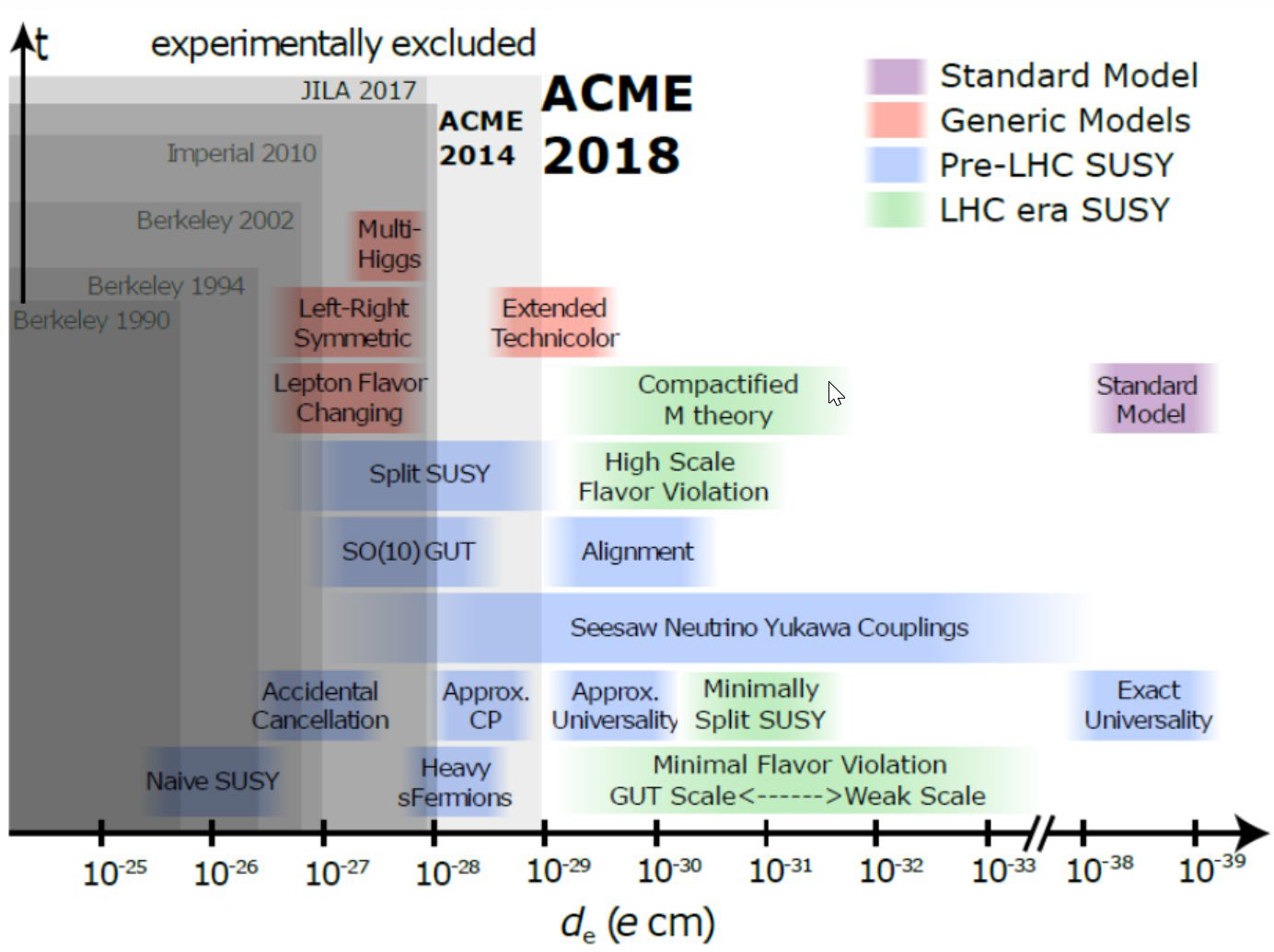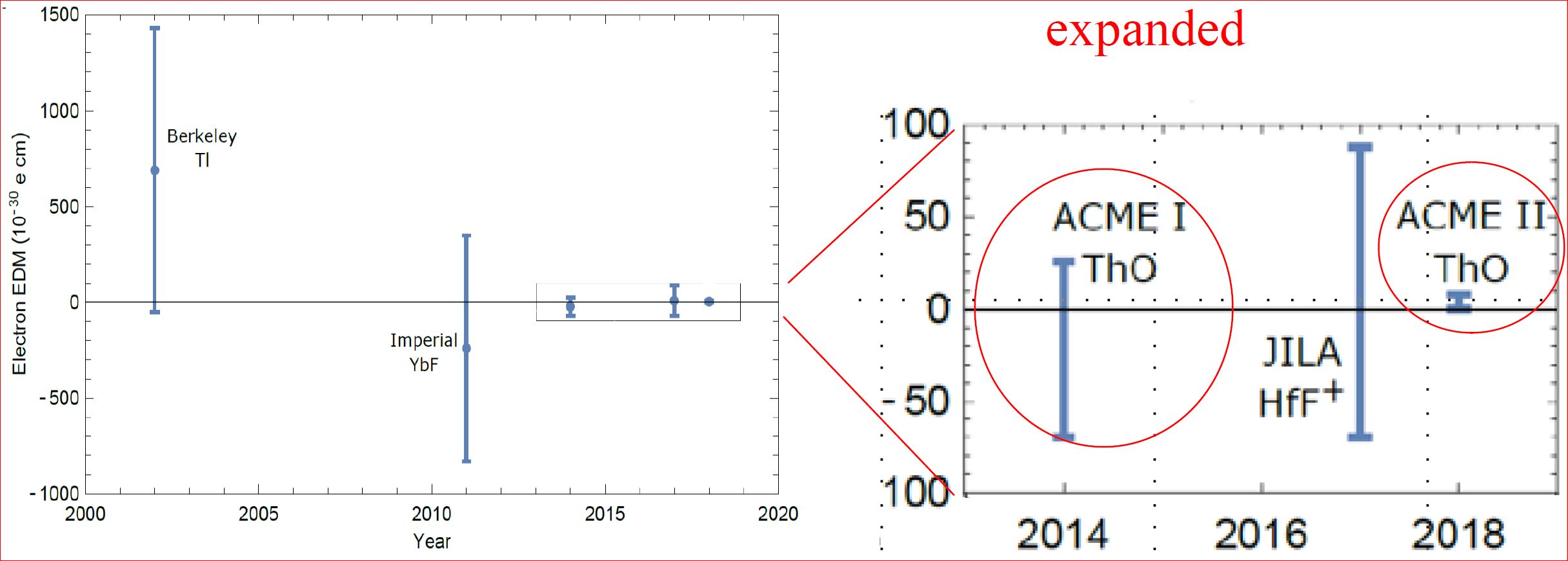ACME Members from the Gabrielse Group

|

|

|

|

|

|

|
| Daniel Ang | Cole Meisenhelder | Siyuan Liu | Bingjie Hao | John Mitchell | Dan Lascar | Gerald Gabrielse |
ACME is a collaboration of Northwestern University, Harvard University, the University of Chicago, and Okayama University. It is supported by the NSF, the Moore Foundation, and the Sloan Foundation. The website for the entire collaboration is at http://www.electronedm.info
The electron certainly has a magnetic dipole moment; the Gabrielse group has measured the electron magnetic moment much more accurately than has any other research group - to an accuracy of 3 parts in 1013 [1].
Does the electron also have an electric dipole moment? No electron electric dipole moment (EDM) has been detected so far. The Standard Model of particle physics predicts that the electron EDM is so small that it probably will not be possible to ever detect it in the foreseeable future. However, various theories beyond the SM predict a value several orders of magnitude larger (Fig. 1). A non-zero EDM would be evidence of T-violation, which by the CPT theorem would imply CP-violation. Many theories predict larger amounts of CP-violation than currently known in order to explain the prevalence of matter over antimatter in the universe [2,3]. Thus, the electron EDM is a powerful probe of physics beyond the Standard Model.

Fig. 1. Predicted electron electric dipole moments (compiled by D. DeMille)
ACME, short for "Advanced Cold Molecule Electric Dipole Moment Search", is a collaboration of the Gabrielse research group with the research groups of John Doyle (Harvard), David DeMille (Chicago), and Okayama University. ACME measures the electron EDM by performing a spin precession experiment in the H3Δ1 state of thorium monoxide (ThO, Fig. 2). A cryogenic beam of ThO molecules is created using ablation and buffer gas cooling. Optical pumping and STIRAP are used to efficiently transfer the molecules into the EDM-sensitive H-state and prepare them in a coherent superposition of M = ±1 states. The quantum state of the molecules undergoes precession in the presence of applied electric and magnetic fields. Finally, the accumulated phase is read out by projection into orthogonal bases using a readout laser with rapidly switched linear polarization. By performing the experiment multiple times with different relative directions of the applied fields, we are able to isolate the amount of precession accumulated due the electron EDM.

Fig. 2. Schematic of the planned ACME III apparatus
The H-state of the ThO molecule provides multiple advantages in performing an extremely precise measurement of the electron EDM:
In 2014, the ACME I experiment placed an upper limit on the electron EDM twelve times better than the previous measurement (|de| ≤ 8.7 x 10-29 e · cm) [9].
In 2018, the ACME II experiment improved on this limit by almost another order of magnitude: |de| ≤ 1.1 x 10-29 e · cm [10]. This was a probe of physics beyond the Standard Model at the 3-30 TeV level (comparable to energies being probed at the Large Hadron Collider), setting significant constraints on supersymmetric and other theories beyond the Standard Model [11].

Fig. 3. Upper bounds on the electron EDM set by ACME, UC Berkeley [12], Imperial College [13], and JILA [14].
The new, five times longer ACME III apparatus, now being designed and built for installation at Northwestern University, will greatly increase the quantum precession time to reduce the measurement uncertainty (Table 1). A hexapole electrostatic lens [15] and more efficient molecular state detection will further reduce the uncertainty.
| Improvement | Signal gain | EDM sensitivity gain |
| Increased precession time | 5.0 | |
| Increased flux of usable molecules | ||
| Increased decay time | 0.45 | 0.67 |
| Electrostatic lens | 9.6 | 3.1 |
| SiPM detector upgrade | 2.3 | 1.5 |
| Improved collection optics | 1.5 | 1.2 |
| Timing jitter noise reduction | 1 | 1.7 |
| Total | 14.9 | 31.8 |
Table 1. Projected gains in statistical sensitivity in the next generation apparatus relative to ACME II
Other upgrades aim to decrease susceptibility to known systematic errors, such as a new set of magnetic shields, coils, and field monitoring capabilities, new electric field plates, and performing STIRAP state preparation on a stronger transition. The new apparatus and measurements provide a path to an ACME III measurement of the electron EDM that has an order of magnitude greater sensitivity than did ACME II.
[1] D. Hanneke, S. Fogwell, and G. Gabrielse, New Measurement of the Electron Magnetic Moment and the Fine Structure Constant, Phys. Rev. Lett. 100, 120801 (2008).
[2] T. Chupp and M. Ramsey-Musolf, Electric Dipole Moments: A Global Analysis, Phys. Rev. C 91, 035502 (2015).
[3] T. E. Chupp, P. Fierlinger, M. J. Ramsey-Musolf, and J. T. Singh, Electric Dipole Moments of Atoms, Molecules, Nuclei, and Particles, Rev. Mod. Phys. 91, 015001 (2019).
[4] L. V. Skripnikov, Combined 4-Component and Relativistic Pseudopotential Study of ThO for the Electron Electric Dipole Moment Search, J. Chem. Phys. 145, 214301 (2016).
[5] T. Fleig and M. K. Nayak, Electron Electric Dipole Moment and Hyperfine Interaction Constants for ThO, J. Mol. Spectrosc. 300, 16 (2014).
[6] A. C. Vutha, B. Spaun, Y. V. Gurevich, N. R. Hutzler, E. Kirilov, J. M. Doyle, G. Gabrielse, and D. DeMille, Magnetic and Electric Dipole Moments of the H 3Δ1 State in ThO, Phys. Rev. A 84, 034502 (2011).
[7] C. D. Panda, Order of Magnitude Improved Limit on the Electric Dipole Moment of the Electron, Harvard University, 2019.
[8] N. R. Hutzler, M. F. Parsons, Y. V. Gurevich, P. W. Hess, E. Petrik, B. Spaun, A. C. Vutha, D. DeMille, G. Gabrielse, and J. M. Doyle, A Cryogenic Beam of Refractory, Chemically Reactive Molecules with Expansion Cooling, Phys. Chem. Chem. Phys. 13, 18976 (2011).
[9] The ACME Collaboration: J. Baron, W. C. Campbell, D. DeMille, J. M. Doyle, G. Gabrielse, Y. V. Gurevich, P. W. Hess, N. R. Hutzler, E. Kirilov, I. Kozyryev, B. R. O’Leary, C. D. Panda, M. F. Parsons, E. S. Petrik, B. Spaun, A. C. Vutha, and A. D. West, Order of Magnitude Smaller Limit on the Electric Dipole Moment of the Electron, Science 343, 269 (2014).
[10] The ACME Collaboration: V. Andreev, D. G. Ang, D. DeMille, J. M. Doyle, G. Gabrielse, J. Haefner, N. R. Hutzler, Z. Lasner, C. Meisenhelder, B. R. O’Leary, C. D. Panda, A. D. West, E. P. West, X. Wu, Improved Limit on the Electric Dipole Moment of the Electron, Nature 562, 7727 (2018).
[11] C. Cesarotti, Q. Lu, Y. Nakai, A. Parikh, and M. Reece, Interpreting the Electron EDM Constraint, J. High Energy Phys. 2019, 59 (2019).
[12] B. C. Regan, E. D. Commins, C. J. Schmidt, and D. DeMille, New Limit on the Electron Electric Dipole Moment, Phys. Rev. Lett. 88, 071805 (2002).
[13] J. J. Hudson, D. M. Kara, I. J. Smallman, B. E. Sauer, M. R. Tarbutt, and E. A. Hinds, Improved Measurement of the Shape of the Electron, Nature 473, 7348 (2011).
[14] W. B. Cairncross, D. N. Gresh, M. Grau, K. C. Cossel, T. S. Roussy, Y. Ni, Y. Zhou, J. Ye, and E. A. Cornell, Precision Measurement of the Electron’s Electric Dipole Moment Using Trapped Molecular Ions, Phys. Rev. Lett. 119, 153001 (2017).
[15] X. Wu, Z. Han, J. Chow, D. G. Ang, C. Meisenhelder, C. D. Panda, E. P. West, G. Gabrielse, J. M. Doyle, and D. DeMille, The Metastable Q3Δ2 State of ThO: A New Resource for the ACME Electron EDM Search, New J. Phys. 22, 023013 (2020).
© 2021 - Last Updated: 02/11/2021 - Disclaimer